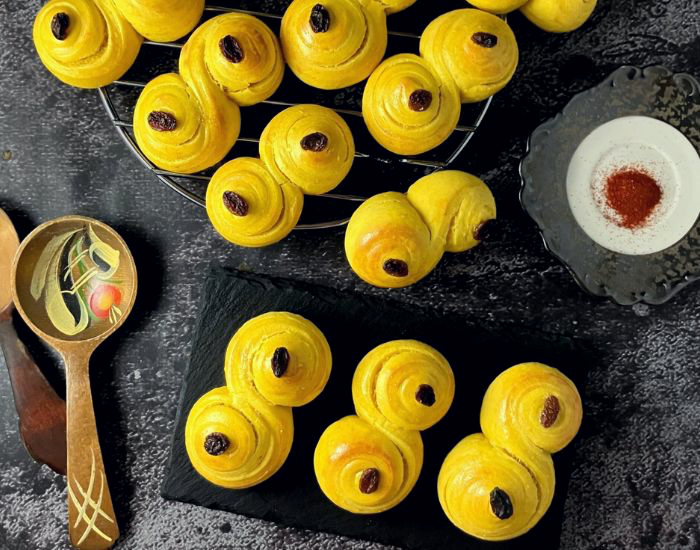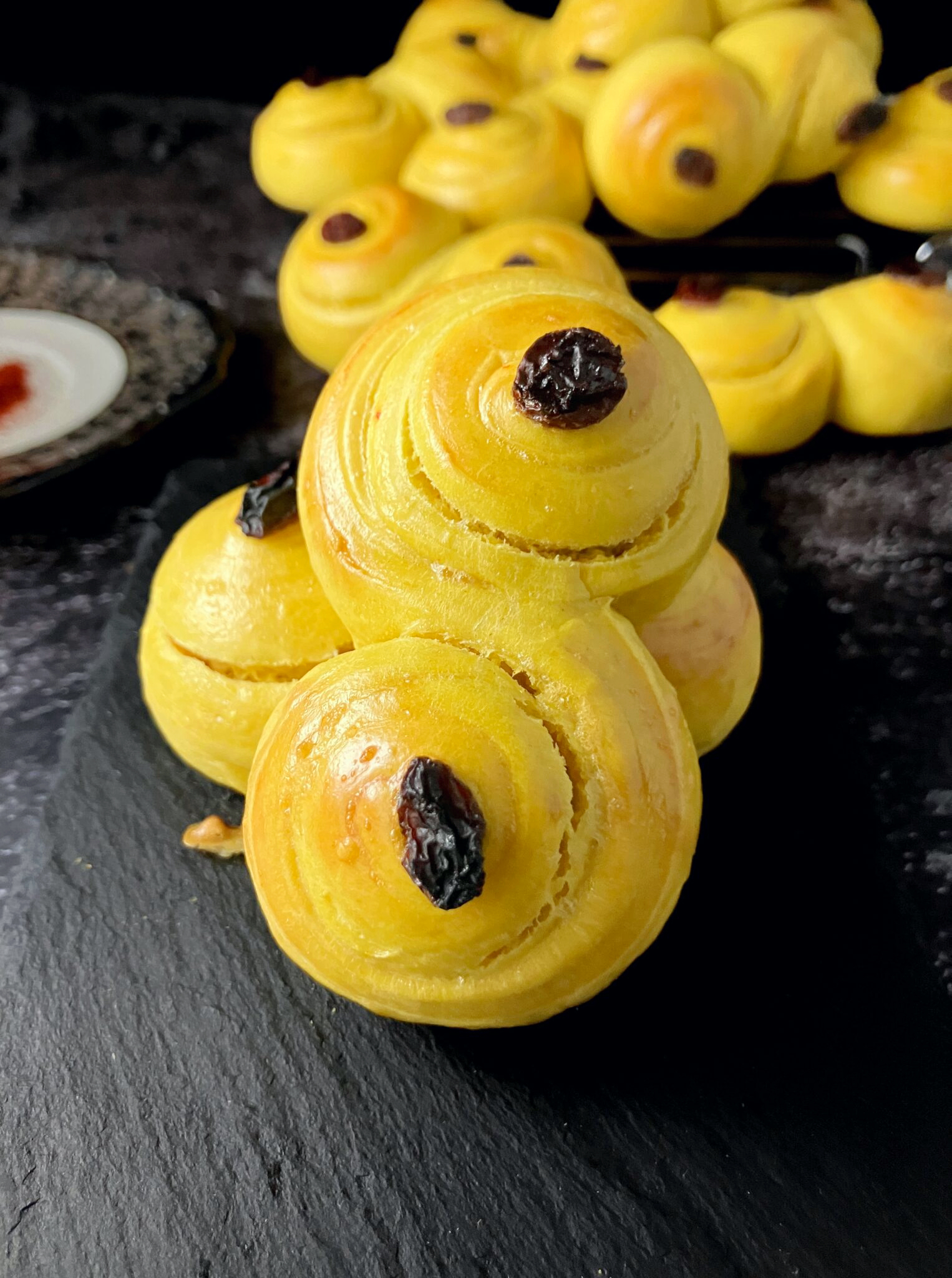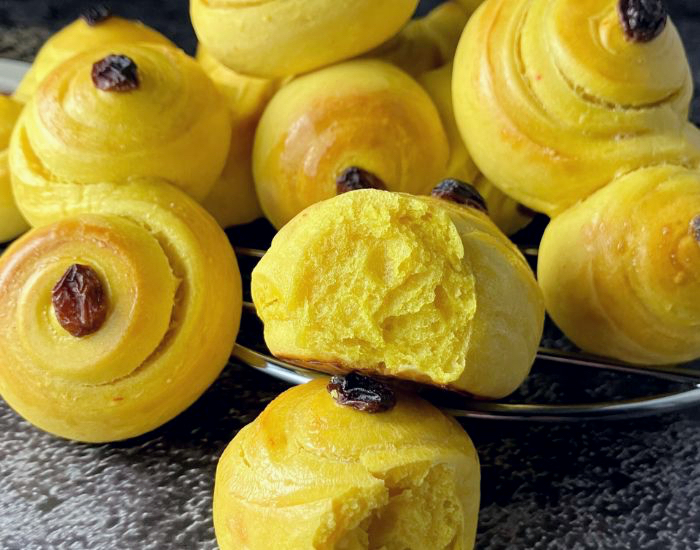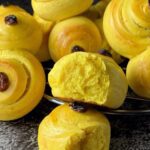Spelt Flour Swedish Lussekatter
As the dark Swedish winter approaches, few treats signal the festive season like lussekatter, the golden saffron buns baked for Saint Lucia’s Day. Delicately scented with saffron, lightly sweetened, and beautifully twisted into traditional S shapes, these buns are a symbol of light, warmth, and celebration.
In this post, I’ll share a version that stays true to tradition, with a few personal tweaks: slightly less butter and saffron, and using spelt flour (with the option to use regular flour).
My Swedish lussekatter
These sweet, fairly dense buns are among Sweden’s most beloved seasonal bakes and are infused with the distinctive flavour of saffron. I make mine with spelt flour, though you can use regular flour if you prefer.
My recipe follows the traditional ingredients of lussekatter, but I’ve used slightly less butter and saffron. The buns are also a little daintier, and the dough is enough to make 12 saffron buns.
What are lussekatter?
Lussebullar is the umbrella term for saffron buns. Directly translated, the name means Lusse = relating to Saint Lucia and bullar = buns. However, the most iconic version is the S-shaped lussekatter. In Swedish, katter means “cats,” and although the name’s exact origins remain a little mysterious, people often say the curled shape resembles a cat’s tail. Bakers usually finish each twist with a single raisin in the centre of the curl.
Other traditional shapes also appear, such as figure-eights, crosses, or intricate braided patterns, each with its own story and regional variation. Just have a look at how many gorgeous ways the saffron buns can be shaped. No matter the shape, what never changes is the unmistakable scent of saffron and the radiant yellow colour that make these buns a true symbol of light in the dark Swedish winter.
They are loved for their delicate aroma, soft texture, and gorgeous golden hue. These festive buns are baked to celebrate Saint Lucy’s Day on 13th December, but their arrival in bakeries and cafés gets earlier every year. I noticed some in my local supermarket the other day, and with it still fairly warm outside and only in the middle of October, it felt a little wrong. A bit like putting your Christmas tree up in early November.
A little history about St Lucia
The Lucia celebration is a festival of light that brightens the darkest time of year in Sweden. Although where I am (in the south) we don’t have total darkness, in the northern regions, the sun barely rises during midwinter. The day honours Saint Lucia, a figure of hope and light, and has deep roots in both Christian and pre-Christian traditions.
Saffron, once an exceptionally rare and expensive spice, was traditionally saved for special occasions. Using it in these buns gave Lucia Day a touch of luxury and warmth, turning an ordinary morning into something truly festive.
Eating lussekatter on Lucia morning is a cherished tradition in homes, schools, and workplaces. The buns are often served with strong coffee or steaming mugs of glögg (Swedish mulled wine) as families gather to watch or take part in Lucia processions. These processions, with their white gowns, candles, and singing, are a serene and beautiful tradition.
Infusing the saffron in butter
Saffron is a delicate but powerful spice, and properly releasing its colour and aroma is key to making authentic lussekatter. Simply sprinkling saffron directly into the dough won’t give you the vibrant golden hue or the rich, warm flavour that makes these buns so special.
Infusing the saffron in melted butter (or sometimes in warm milk) allows the tiny threads to release their full colour and fragrance. The gentle heat helps the saffron oils bloom, creating a deep, fragrant liquid that permeates the dough evenly. This step ensures that every bite carries that signature saffron aroma and that beautiful, sunlit yellow colour.
Why saffron buns are slightly denser
Lussekatter have a denser texture compared to other enriched sweet breads like brioche. Kanelbullar (Swedish cinnamon buns) have a softer, airier crumb because the butter and sugar filling rolled into the dough creates layered pockets, making the buns more tender than the slightly denser lussekatter.There are a few reasons for this:
- Moderate fat content: Unlike brioche, which contains a high proportion of butter and eggs, traditional saffron buns have only a modest amount of butter and just one egg. This makes the dough enriched but not overly light, giving it structure without being too soft.
- Sugar and flour ratio: Lussekatter use relatively little sugar, which slows down yeast activity slightly, resulting in a slower rise and a tighter crumb. It’s important not to add too much flour, as this will contribute towards a denser bun.
- Handling and shaping: The dough is shaped into S forms or other intricate twists. Each roll compresses the dough slightly, which naturally creates a firmer texture once baked.
- Proofing time: Traditional recipes often allow a moderate rise, not an extended one. The dough is soft but not airy, so the buns remain tender yet slightly compact.
Preparing the lussekatter shape
In the past, I’ve made lussekatter the most traditional way, which is rolling a strip of dough between my hands and curling the ends into the classic S shape. It’s quick, simple, and gives that instantly recognisable look.
This time, though, I wanted to create a neater, more defined swirl. Instead of shaping the dough by hand, I rolled it out into a large rectangle and cut it into even strips. To shape each one, I took the end of the strip furthest away from me and rolled it towards me until half way down. Then I flipped the strip over so that the rolled part was underneath, and rolled the other end up towards the middle from the opposite direction.
This creates two even spirals that meet perfectly in the centre, giving the buns a beautifully balanced S shape. It also helps them keep their form during baking and really shows off that striking saffron colour. Then, before baking, all it needs is a strategically placed raisin.
Storing lussekatter
Lussekatter are at their best straight from the oven, when the crumb is still slightly dense, tender, and fragrant. Because of their modest fat content and slightly compact structure, they don’t stay soft for long. So, they are really best enjoyed on the day they are baked.
Using spelt flour, as in my version, can make baked goods stale even more quickly. Any buns that aren’t eaten on the first day should be frozen as soon as they’ve cooled. Then, defrosted when needed. A quick 10–20 second zap in the microwave or a few minutes in a warm oven will revive them nicely without compromising their texture.
Swedish Lussekatter (saffron buns)
Ingredients
Dough
- 50g (3½ tbsp) butter
- ½ gram (¼ tsp) ground saffron
- 200ml (⅘ cup) milk
- 7g (2¼ tsp) dried yeast (see note 1)
- 1 egg
- 80g (⅓ cup) sugar
- 300g-360g (2½ cups - 3 cups) spelt flour (see note 2)
- 1 small egg (for the egg wash)
- raisins
Instructions
- Melt the butter in a small pan.
- When melted, add the saffron, and allow the mixture to cook for a couple of minutes.
- Remove from the heat, and stir in the milk. Allow to sit for around 15 minutes.
- Add the cooled mixture and the egg to your stand mixer, and give it a quick mix.
- Add the remaining ingredients, and 300g of flour. Work the mixture, gradually adding more flour as necessary. Be careful with this step, as too much flour will result in dry bread. At this stage, the dough should still be a little tacky.
- Switch to a dough hook attachment (if you have one) and knead the dough for around 10 minutes. The dough should be shiny, and drop fairly easily from the hook.
- Cover with a tea-towel and allow the dough to proof for around and hour, or until doubled in size.
- When the dough is ready, line a large baking tray with baking paper.
- Pre-heat the oven to 200℃ (400℉).
- Knock back the dough, and roll out into a long rectangle of around 40cm x 32cm (15¾" x 12½").
- Cut into 12 strips (the thinner the strip, the smaller/flatter the buns) - see note 3.
- Taking the end furthest away from you, roll up the strip. When you reach half way, turn the strip over, so that the rolled part is underneath.
- Roll up the end closest to you until it reaches the other half. Turn sideways, and place on the prepared tray.
- Repeat with the other strips.
- Cover again, and leave for a further 45 minutes.
- Beat the egg, and wash over the tops of the buns. Push a raisin into each end (in the middle of the spirals).
- Bake for 8-14 minutes, depending on size (mine were small, so I baked them for 9 minutes). The buns are ready when they are starting to brown on top. Be careful not to overtake .
- Remove from the oven and allow to cool. The buns are best served warm. Please note: the buns do get dry quite quickly, so if you are eating the next day, give them a quick 20 seconds in the microwave before eating. Enjoy!
Notes
- In Sweden we have something called dried yeast. It is used both in warm liquid to proof and also added directly to flour. I am aware that the US has two options for dried yeast, and I believe instant yeast is the most similar for the purpose of making this particular recipe.
- You can use spelt or regular flour for this recipe (just use the same amount).
- The ingredients made 12 small buns. You can make them bigger (taller) by making your strips a little thicker. The baking times may vary, depending on the size of your buns. Read here for more information about how to create the shape.









3 thoughts on “Spelt Flour Swedish Lussekatter”